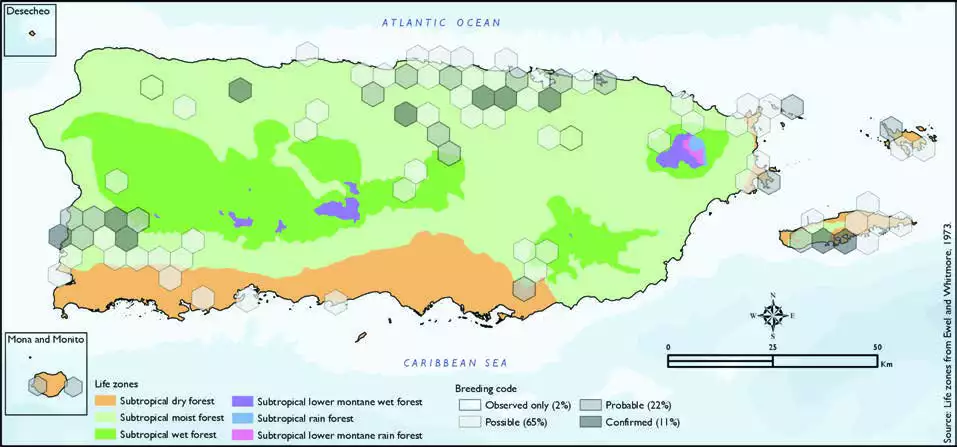White-crowned Pigeon
Description
The white-crowned pigeon (Patagioenas leucocephala) is a fruit and seed-eating species of bird in the dove and pigeon family Columbidae. It is found primarily in the Caribbean.
Distribution & Habitat
The White-crowned Pigeon is a common to locally common
breeding resident in The Bahamas,
Cuba, Jamaica, Antigua, Hispaniola,
Puerto Rico, the Virgin Islands, San
Andrés, and Providencia (Raffaele
and others 1998). It is a common to
fairly common resident in Vieques
(Biaggi 1997, Gemmill 2015) and is
also fairly common on Culebra and
Mona (Ventosa-Febles and others
2005). The resident population
on Puerto Rico is believed to be
augmented in spring and summer
by visiting White-crowned Pigeons
from other islands, which also breed on the main and satellite
islands (Raffaele 1989a). Wetmore
(1916) found the White-crowned
Pigeon in only a few localities on
the north coast of Puerto Rico (e.g.,
Punta Picu, north of Mameyes)
and suggested that the species
was more abundant on the island
in the 1870s as described by
Gundlach (1878). The populations
of White-crowned Pigeons were
sufficiently abundant for detailed
studies of nesting biology in Mona,
Dorado, and Roosevelt Roads Naval
Base during 19731975 by Wiley
and Wiley (1979). Both Raffaele
(1989b) and Oberle (2018) note
that the pigeon is common in
Dorado. During 19952008, the
White-crowned Pigeon population
increased from low numbers,
possibly due to increased second-
growth forests used for foraging
and nesting (Rivera-Milán 1996, 2001). The species usually inhabits
coastal woodlands and mangroves
during the breeding season but can
be found inland in the mountains
when not breeding (Raffaele and
others 1998). The atlas fieldwork
yielded a total of 139 records within
88 hexagons or 18 percent of the
479 total hexagons (see map). In
the 88 hexagons where this species
was found, breeding met the atlas
definition of confirmed in 11 percent
(10) of the hexagons, probable in
22 percent (19), and possible in 65
percent (57), while the species was
observed in 2 percent (2) of the
hexagons but without evidence of
breeding (see map). Atlas results
suggest that the pigeon may still be
expanding its breeding range on
Puerto Rico where it remains fairly
local and common in southwestern,
north-central, and eastern portions
of the island.White-crowned Pigeon distribution. The map shows the highest breeding code by hexagon and overlaying the ecological life zones
in Puerto Rico. Note: percentages may not total 100 due to rounding. 45White-crowned Pigeon/Paloma Cabeciblanca

Breeding Habits
The White-crowned Pigeon generally nests in colonies and builds a fl imsy
twig nest, usually in mangroves or
dry scrub but also in trees around
towns (Raffaele and others 1998).
In Puerto Rico some birds breed
in trees bordering a golf course
(Wiley and Wiley 1979). Both sexes
share the building of the nest and
egg incubation; the male does most
of the incubation during the day,
while the female incubates mostly
at night (Wiley and Wiley 1979).
Previously published reports indicate
that breeding occurs primarily from
March to August but sometimes
as late as September (Raffaele and
others 1998, Wiley and Wiley 1979).
However, breeding season may vary
with location on the island, and
breeding in the southwest is not always synchronized with breeding
in the northeast portion of the
island. Atlas results suggest that this
species breeding season extends
throughout the year with most
breeding activity from April to June
(see chart). The breeding activity
peaks in May and mostly takes place
within the subtropical moist forest
life zone (see chart). Results show
that this species breeds mostly in
lowlands within the subtropical
moist forest life zone (67 percent
of the hexagons) (see table). It
also breeds in the subtropical dry
forest life zone (27 percent of the
hexagons) (see table and map).
Conservation
The current population trend of the
White-crowned Pigeon is described as decreasing (Butcher and Niven
2007). This species is currently
listed as a near threatened species
by the IUCN (BirdLife International
2016). In Puerto Rico, the White-
crowned Pigeon is classified as data
deficient (PRDNER 2016). A decline
in abundance in counts during 2008
2014 suggests that increased illegal
hunting may have been a driver
of the observed decline, although
urban development and other threats
could also have affected the islands
population (Rivera-Milán and others
2016). In Puerto Rico, the White-
crowned Pigeon has a protected
habitat in land of 16.8 percent or
343 km2 of the total area covered by the hexagons where evidence of
breeding was found for this species
(2031 km2).
Related Species
Family:
pigeon